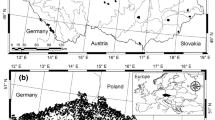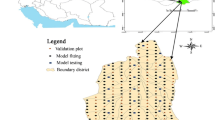Abstract
Understanding the relationship between tree height (H) and diameter at breast height (D) is vital to forest design, monitoring and biomass estimation. We developed an allometric equation model and tested its applicability for unevenly aged stands of moso bamboo forest at a regional scale. Field data were collected for 21 plots. Based on these data, we identified two strong power relationships: a correlation between the mean bamboo height (H m) and the upper mean H (H u), and a correlation between the mean D (D m) and the upper mean D (D u). Simulation results derived from the allometric equation model were in good agreement with observed culms derived from the field data for the 21 stands, with a root-mean-square error and relative root-mean-square error of 1.40 m and 13.41 %, respectively. These results demonstrate that the allometric equation model had a strong predictive power in the unevenly aged stands at a regional scale. In addition, the estimated average height–diameter (H–D) model for South Anhui Province was used to predict H for the same type of bamboo in Hunan Province based on the measured D, and the results were highly similar. The allometric equation model has multiple uses at the regional scale, including the evaluation of the variation in the H–D relationship among regions. The model describes the average H–D relationship without considering the effects caused by variation in site conditions, tree density and other factors.






Similar content being viewed by others
References
Cortini F, Filipescu CN, Groot A, MacIsaac DA, Nunifu T (2011) Regional models of diameter as a function of individual tree attributes, climate and site characteristics for six major tree species in Alberta, Canada. Forests 2:814–831
Fang ZX, Bailey RL (1998) Height-diameter models for tropical forests on Hainan Island in southern China. For Ecol Manag 110:315–327
Feldpausch TR, Banin L, Phillips OL, Baker TR, Lewis SL, Quesada CA, Affum-Baffoe K, Arets E, Berry NJ, Bird M, Brondizio ES, de Camargo P, Chave J, Djagbletey G, Domingues TF, Drescher M, Fearnside PM, Franca MB, Fyllas NM, Lopez-Gonzalez G, Hladik A, Higuchi N, Hunter MO, Iida Y, Salim KA, Kassim AR, Keller M, Kemp J, King DA, Lovett JC, Marimon BS, Marimon BH, Lenza E, Marshall AR, Metcalfe DJ, Mitchard ETA, Moran EF, Nelson BW, Nilus R, Nogueira EM, Palace M, Patino S, Peh KSH, Raventos MT, Reitsma JM, Saiz G, Schrodt F, Sonke B, Taedoumg HE, Tan S, White L, Woll H, Lloyd J (2011) Height-diameter allometry of tropical forest trees. Biogeosciences 8:1081–1106
Inoue A (2013) Culm form analysis for bamboo, Phyllostachys pubescens. J For Res 24:525–530
Inoue A, Yoshida S (2004) Allometric model of the height-diameter curve for even-aged pure stands of Japanese cedar (Cryptomeria japonica). J For Res 9:325–331
Inoue A, Sakamoto S, Suga H, Kitahara F (2011) Estimation of culm volume for bamboo, Phyllostachys bambusoides, by two-way volume equation. Biomass Bioenerg 35:2666–2673
Johansson T (2012) Site index curves for young hybrid larch growing on former farmland in Sweden. Forests 3:723–735
Kaufman L, Rousseeuw PJ (2005) Finding groups in data: an introduction to cluster analysis. Wiley, Hoboken
Ketterings QM, Coe R, van Noordwijk M, Ambagau Y, Palm CA (2001) Reducing uncertainty in the use of allometric biomass equations for predicting above-ground tree biomass in mixed secondary forests. For Ecol Manag 146:199–209
Lopez-Serrano FR, Garcia-Morote A, Andres-Abellan M, Tendero A, del Cerro A (2005) Site and weather effects in allometries: a simple approach to climate change effect on pines. For Ecol Manag 215:251–270
McClure FA (1966) The bamboos: A fresh perspective. Harvard University Press, Cambridge
McMahon T (1973) Size and shape in biology. Science 179:1201–1204
McMahon TA, Kronauer RE (1976) Tree structures: deducing the principle of mechanical design. J Theor Biol 59:443–466
Murtagh F (1985) Multidimensional clustering algorithms. Physika Verlag, Vienna
Newaz MS, Millat-E-Mustafa M (2004) Growth and yield prediction models for Acacia mangium grown in the plantations of the central region of Bangladesh. New For 27:81–88
Niklas KJ (1993) The scaling of plant height: a comparison among major plant clades and anatomical grades. Ann Bot 72:165–172
Osumi S, Kajihara M, Ouchi Y, Imanaga M, Sugawara S, Kitamura M, Shibata N, Ishikawa Y (1987) Forest mensuration. Yokendo Press, Tokyo
Paulo JA, Tome J, Tome M (2011) Nonlinear fixed and random generalized height-diameter models for Portuguese cork oak stands. Ann For Sci 68:295–309
Peng C, Zhang L, Liu J (2001) Developing and validating nonlinear height-diameter models for major tree species of Ontario’s boreal forests. North J Appl For 18:87–94
R Core Team (2013) R: a language and environment for statistical computing. R Foundation for Statistical Computing, Vienna
Saunders MR, Wagner RG (2008) Height-diameter models with random coefficients and site variables for tree species of Central Maine. Ann For Sci 65:1–10
Song X, Zhou G, Jiang H, Yu S, Fu J, Li W, Wang W, Ma Z, Peng C (2011) Carbon sequestration by Chinese bamboo forests and their ecological benefits: assessment of potential, problems, and future challenges. Environ Rev 19:418–428
SPSS (2004) SPSS 13.0 for the Windows. SPSS Inc., Chicago, IL
Stark H, Nothdurft A, Bauhus J (2013) Allometries for widely spaced Populus ssp. and Betula ssp. in nurse crop systems. Forests 4:1003–1031
Takashima A, Kume A, Yoshida S, Murakami T, Kajisa T, Mizoue N (2009) Discontinuous DBH-height relationship of Cryptomeria japonica on Yakushima Island: effect of frequent typhoons on the maximum height. Ecol Res 24:1003–1011
Wang XP, Fang JY, Tang ZY, Zhu B (2006) Climatic control of primary forest structure and DBH-height allometry in Northeast China. For Ecol Manage 234:264–274
Ward JJH (1963) Hierarchical grouping to optimize an objective function. J Am Stat Assoc 58:236–244
Watanabe M, Oohata S (1980) Studies on bamboo culm form (I) On Phyllostachys bambusoides Sieb. et Zucc. J Jap For Soc 62:9–16
Watanabe M, Inoue M, Takano T (1989) Discussion on the prediction of culm height in Phyllostachys bambusoides bamboos. Bamboo J 7:27–38
West GB, Brown JH, Enquist BJ (1997) A general model for the origin of allometric scaling laws in biology. Science 276:122–126
West GB, Brown JH, Enquist BJ (1999) A general model for the structure and allometry of plant vascular systems. Nature 400:664–667
Zhang LJ (1997) Cross-validation of non-linear growth functions for modelling tree height-diameter relationships. Ann Bot 79:251–257
Zhou FC (1998) Bamboo forest silviculture. China Forestry Publishing House, Beijing
Acknowledgments
This study was financially supported by the Special Fund for Basic Scientific Research of International Centre for Bamboo and Rattan (1632014003) and National Natural Science Foundation of China (31101148 and 31300177). We also thank Chief Engineer Fenghua Hu (Forestry Bureau of Huangshan, Anhui Province, China) and Chief Engineer Guanghui Lai (Forestry Bureau of Guangde County, Anhui Province, China) for their help in field survey, and Nuoli Gao (International Center for Bamboo and Rattan) for correcting the English of the text.
Author information
Authors and Affiliations
Corresponding authors
Additional information
Project funding: This study was financially supported by the Special Fund for Basic Scientific Research of International Centre for Bamboo and Rattan (1632014003) and National Natural Science Foundation of China (31101148 and 31300177).
The online version is available at http://www.springerlink.com
Corresponding editor: Chai Ruihai
Appendix
Appendix
During model evolution, uncertainty on the variables H m and D m in Eqs. 1 and 2 can certainly propagate into Eq. 14. As addressed in the main text, we first obtained Eq. 6 by combining Eq. 1 with Eq. 5 and eliminating H u, and by substituting Eq. 2 into Eq. 6, we obtained Eq. 7:
The general form of Eq. 14 was expressed using Eq. 15:
Replacing α with Eq. 7, we obtained the Eq. 16:
We assumed that the expected e Hm and e Dm deviate by small amounts δH m and δD m, normally distributed with zero mean and with standard deviations σH m and σD m. The uncertainty on the estimate of H (culm height) associated with the measurement is measured by the standard deviation. Thus, the model error (σ H ) can be written as:
H m, D m, \( \sigma_{{H_{\text{m}} }}^{{}} \), \( \sigma_{{D_{\text{m}} }}^{{}} \) and \( \sigma_{{H_{\text{m}} D_{\text{m}} }}^{{}} \) were estimated as 10.41 m, 7.74, 1.52 cm, 1.59 m and 25.32 m cm, respectively. If one assumes a 10 % uncertainty on the measurement of D, the model error (σ H ) is thus 33.17 % of H.
Rights and permissions
About this article
Cite this article
Gao, X., Li, Z., Yu, H. et al. Modeling of the height–diameter relationship using an allometric equation model: a case study of stands of Phyllostachys edulis . J. For. Res. 27, 339–347 (2016). https://doi.org/10.1007/s11676-015-0145-6
Received:
Accepted:
Published:
Issue Date:
DOI: https://doi.org/10.1007/s11676-015-0145-6




